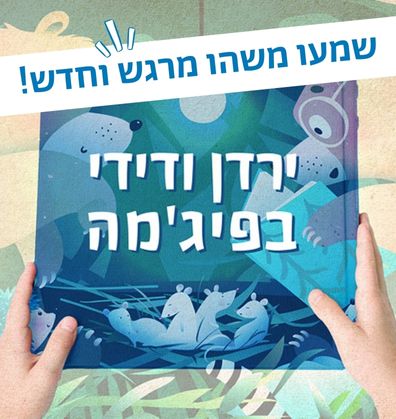חַגִּים וְיָמִים מְיֻחָדִים
ראש השנה
שנה חדשה מתחילה ואיתה שלל תקוות נרגשות וגם חשש משינויים ומהבלתי ידוע. את ההתחדשות והצמיחה יכולים ללוות ספרים אהובים, ספרים על התחלות חדשות, על הסתגלות, וגם ספרים בהם תמצאו שירים אהובים לראש השנה או רימון ותפוחים מתוקים.
סְּפָרִים
Book-Related Family Activities
Songs for all Times
This book is a gift that can accompany you as a family throughout the year: on festive holidays and in changing seasons, with the arrival of Autumn and in preparation for a birthday celebration. Choose the appropriate song for each coming occasion or holiday, read it together, look at the illustrations, sing and celebrate. Poems and illustrations Read the songs together and look at the illustrations. Which illustrations attract the children’s attention?
Songs and Illustrations
Read the songs together and study the illustrations. Which illustrations draw the children’s attention?
You can look together at what you see in the illustration and what details appear in it.
Words and Melodies
Many of the songs in this book were composed to music. You can take a cymbals, wooden spoons or lids of pots and pans, and accompany the singing by playing music and dancing. Once the children are familiar with the song, you can play a guessing game: starting humming the tune, and invite the children to guess the rest and join you.
What’s Hiding in the illustration?
Open the book randomly, or at a favorite song, and let each person in turn name an item that everyone else must look for in the illustration: Find in the illustration: Where is the house with a red roof? Where is the pomegranate? Where are the clowns?
Sitting close and reading together
Sitting close and reading together – You may want to look for the illustration of the wilted tree, stop reading, and ask your child for their opinion as to why the tree is not blooming, and what it is missing. At the end of the story, you may want to discuss what caused the tree to bloom once again, and whether that was Mr. Zuta’s intention when he planted the flower patches.
Do trees have feelings?
Do trees have feelings? Perhaps you would enjoy looking for the page on which Mr. Zuta’s friends suggest that he get rid of the tree. You could imagine a dialogue taking place. If the tree could speak, what would it say to Mr. Zuta and his friends?
I want a garden too!
I want a garden too! – Mr. Zuta is jealous of his friends’ gardens. You may want to share a memory with your child of having wanted something that another person had. How did you feel? What did you do? If you would like to have a garden too, you could plant flowers, herbs, or vegetables in your yard or window-box. Look after your plants, and watch them grow.
Planting a community garden together
Planting a community garden together – You may want to take a walk in the area surrounding your home. Are there any open spaces, or abandoned courtyards? You could clean up the area together with some friends, and make it more beautiful. You could even plant a community garden in collaboration with your neighbors.
Right under one's nose
Right under one’s nose – Mr. Zuta did not notice the change in his apple tree until his friends remarked on it. Have you ever failed to notice something good that was happening around you? You may enjoy walking through your house and backyard, looking for all the beautiful things that have grown or changed there lately.
A recipe for apple crumble
Ingredients
For the crumbs:
100g of sugar
80g of butter, cubed
100g of flour
For the apples:
5–6 apples
20g of butter
3 tablespoons of sugar (you could add a tablespoon of cinnamon or lemon juice, depending on your preference).
Method:
- Mix the sugar, butter, and flour together until you get medium-sized crumbs. Store in fridge for one hour.
- Peel the apples, and cut them into wedges.
- Melt the butter in a frying pan, and cook the apples in it for 10–15 minutes while stirring, until the apples are soft, but retain their shape.
- Place the apples in a baking pan, sprinkle the crumbs on top, and bake in medium–high heat for approximately 20 minutes, until golden.
- Serve hot or at room temperature. Bon Appetit!
Family Activities
- You may want to look through the book and enjoy the lovely illustrations. Can you spot the apple on every page? Some of the objects and animals remain constant, while others change position. Which are constant? Which are in motion?
- Have you noticed that the mouse is smiling almost throughout the book? How do you think it feels while waiting patiently?
- You may want to take puppets or stuffed animals to represent the characters in the story, and act it out to your family and friends.
- We all lose our patience at times, waiting on line at the cashier, or getting stuck in traffic. You may like to share an experience with your child in which you finally made it after having waited for something for a long time. What ‘gift’ did you get at the end of the long wait?
- Many children find it hard to wait for their parent to finish what they are doing, or for their turn to be on the computer. Perhaps you could mark the time left to wait on an analog clock. Children are often more patient when they know when their “patience time” will be over.
How about putting on your aprons and making apple confit?
Ingredients:
1 kg of green apples
1/2 kg of sugar
1 cinnamon stick
1 lemon
Peel the apples with a peeler, take out the cores and dice them. Cook the apples, sugar and cinnamon stick in a pot on a small burner for one hour (you must be patient!). Once cooked, add some squeezed lemon to your confit.
Be-teavon! Bon Appetit!
מסיבת פיג'מות בגן
כדאי לערוך מסיבת פיג’מות בגן, יחד עם ההורים אחרי שעות הגן או עם הילדים בלבד בשעות הבוקר, ולקרוא יחד את הסיפור. אפשר לקשט את הגן עם תפאורה של כוכבים וירח ולהזמין את כולם להתכרבל יחד, ליהנות מהאיורים הרכים שמלווים את הסיפור ולעקוב אחר מסע ההתבגרות של נינה.
לשוחח עם הילדים על ההבדלים בין חלום ומציאות
“עכשיו לילה, אבל נינה חושבת שהיא ערה”. אפשר לשוחח עם הילדים על ההבדלים בין חלום ומציאות: האם גם לכם קרה פעם שלא הייתם בטוחים אם אתם ערים או ישנים? מה יכול לקרות בחלום ולא במציאות? אפשר לתת דרור לדמיון ולצייר ציור שכולו חלום.
להשוות את הסיפור
אפשר להשוות את הסיפור עם להיזכר בספר אחר שחולק השנה, “אמיליה” מאת נעמה בנזימן, שגם הוא מתאר עלילה דמיונית.
חבריה הצעצועים של נינה
חבריה הצעצועים של נינה חושבים שהיא מוכנה למעבר מזחילה להליכה, אבל נינה לא בטוחה בכך. בכל רגע בחייהם הילדים עומדים בפתח הישג חדש (למשל, מעבר לגן חדש או לכיתה א’, רכיבה על אופניים, עצמאות גוברת בפעולות יומיומיות). אפשר לשוחח על כך ולשאול אלו כוחות דרושים כדי לצלוח את המעבר, האם הם חוששים?
להמציא המשך לסיפור
הסיפור מסתיים בצעדים הראשונים של נינה. תוכלו להמציא המשך לסיפור: לאן נינה הולכת? האם היא גם מועדת ונופלת? איך מגיבים בני המשפחה והחברים כשהם רואים את נינה הולכת? הציעו לילדים לצייר ולכתוב יחד עמוד המשך לספר.
לשוחח עם הילדים על דברים ש'בוגרים' עושים ו'קטנים' עדיין לא
אפשר לשוחח עם הילדים על דברים ש’בוגרים’ עושים ו’קטנים’ עדיין לא. אפשר לערוך רשימה של הישגים ויכולות: מה יודעים הילדים לעשות היום שלא יכלו לעשות בתחילת השנה, ומה הם רוצים ללמוד לעשות כשיהיו בוגרים יותר.
להביא לגן תמונות שלהם כתינוקות
בעקבות הסיפור אפשר לבקש מהילדים להביא לגן תמונות שלהם כתינוקות, ולהציג אותן על לוח יחד עם תמונות שלהם מהשנה. כך כולם יכולים להתגאות ולהתרשם ממסע ההתבגרות של הילדים – וגם להיזכר בצעדים ראשוניים שלהם.
להכין יחד עם ילדיהם אלבום של "צעדים ראשונים"
תוכלו להפנות את ההורים לאחת ההצעות בסוף הספר – להכין יחד עם ילדיהם אלבום של “צעדים ראשונים”: צילומים של הילדים כתינוקות בזרועותיהם, ובהמשך זוחלים, הולכים, מבקרים לראשונה בגן… ולהציע להשאיר דפים ריקים להמשך ההתפתחות (המעבר לכיתה א’, לימוד קרוא וכתוב ועוד הרבה!).
סיפורים ושירים לילדים
נורית זרחי כתבה עשרות סיפורים ושירים לילדים. כדאי לחפש אותם ולקרוא אותם יחד, ולערוך פינה בגן של היוצרת ויצירותיה.
לשוחח עם ילדיכם על ההבדלים בין חלום ומציאות
“עכשיו לילה, אבל נינה חושבת שהיא ערה”. אפשר לשוחח עם ילדיכם על ההבדלים בין חלום ומציאות: האם גם לכם קרה פעם שלא הייתם בטוחים אם אתם ערים או ישנים? מה יכול לקרות בחלום ולא במציאות? אפשר לתת דרור לדמיון ולצייר יחד ציור שכולו חלום.
חבריה הצעצועים של נינה
חבריה הצעצועים של נינה חושבים שהיא מוכנה למעבר מזחילה להליכה, אבל נינה לא בטוחה בכך. האם ילדיכם עומדים בפתח הישג חדש? (למשל, מעבר לגן חדש או לכיתה א’, רכיבה על אופניים…) אפשר לשוחח על כך ולשאול אלו כוחות דרושים כדי לצלוח את המעבר, האם הם חוששים?
לצייר ולכתוב יחד עמוד המשך
הסיפור מסתיים בצעדים הראשונים של נינה. תוכלו להמציא המשך לסיפור: לאן נינה הולכת? האם היא גם מועדת ונופלת? איך מגיבים בני המשפחה והחברים כשהם רואים את נינה הולכת? הציעו לילדיכם לצייר ולכתוב יחד עמוד המשך לספר.
לשוחח עם ילדיכם על דברים ש'בוגרים' עושים ו'קטנים' עדיין לא
אפשר לשוחח עם ילדיכם על דברים ש’בוגרים’ עושים ו’קטנים’ עדיין לא. אפשר לערוך רשימה של הישגים ויכולות של ילדיכם: מה הם יודעים לעשות היום שלא יכלו לעשות לפני שנה, ומה הם רוצים ללמוד לעשות כשיהיו בוגרים יותר.
להיזכר בצעדים ראשוניים של ילדיכם
ילדים רבים אוהבים לשמוע סיפורים על ילדותם המוקדמת. לאחר הקריאה אפשר להתכרבל יחד ולהיזכר בצעדים ראשוניים של ילדיכם. האם אתם זוכרים באיזה גיל הם התחילו לזחול, ללכת, אולי לעמוד על רגל אחת בלי ליפול? אפשר לחפש תמונות ישנות ולהכין יחד אלבום של “צעדים ראשונים”: צילומים של ילדיכם כתינוקות בזרועותיכם, ובהמשך זוחלים, הולכים, מבקרים לראשונה בגן… אל תשכחו להשאיר דפים ריקים להמשך ההתפתחות (המעבר לכיתה א’, לימוד קרוא וכתוב ועוד הרבה!)
לצאת ל"טיול לילה"
כמו נינה וחבריה, גם אתם יכולים לצאת ל”טיול לילה”. האם הסביבה המוכרת נראית שונה בלילה? מה אתם רואים, אלו קולות אתם שומעים? כדאי לקחת שמיכה ועותק של הספר, לשכב על הדשא ולהביט בשמים. יחד אפשר לחפש את הירח (האם הוא “ורוד ושוטף את העצים באור כסף בהיר”, כמו בסיפור?), לִספוֹר כוכבים וללחוש סודות.
לילה טוב וקריאה נעימה מספריית פיג’מה!
Family Activities:
- You can flip through the book together with your children, looking at OraAyal’s heartwarming illustrations and pointing out each of the occasions on which the blanket helped Maya. You might ask your children what they think made the blanket change its size as the story went along.
- Like Maya, many children have a “lovey” (rag, blanket, pacifier, stuffed animal, or doll) that they take with them everywhere. Talk with your children about the strong attachment Maya feels for her “Blankie,” and share your own experiences: When you were young, did you have a favorite object to which you were particularly attached? Do your children have one? Perhaps you, too, want to embark on a “journey” with the item and do some growing with its support.
- Maya really wants to be four years old already. You could ask your children if there are things “big kids” do that “little kids” don’t. Together you could make an illustrated listof your children’s achievements and capabilities: things they know how to do today andcouldn’t do a year ago, and what they would like to be able to do when they are older.
- You might discuss special occasions throughout the year: holidays, the first or last day of school, important events in the life of your family. How do you mark all these occasions? Do you recite the Shehehiyanublessing, and if so – when?
- How does your family celebrate birthdays? Maya’s story underlines the point that maturity is measured not only by how old you are, but also by your actions. After reading the story, you might add a new custom to your family birthday celebrations—one that will give your children a chance to display their new-found maturity. You could suggest that they choose a toy, an item of clothing, or a doll or stuffed animal that they no longer need “because they’re big,” and give it away to a younger child.
- You could also hold a birthday party for one of your children’s dolls or stuffed animals – plan the party, make decorations, sing songs… everything you do for a birthday!
- Young children’s perception of time is not yet fully developed, and many children, like Maya, ask, “When will…?” Working together, you could design a weekly calendar showing all the days of the week, and then mark each passing day with a small picture or sticker.
Family Activities:
- Together with your children, take the time to look closely at Na’ama Benziman’s beautiful illustrations. You may want to stop at the page where Emilia approaches the three steps leading to the preschool, and note the changes in her facial expression.
- After reading the story, you can make up your own fantastic story and draw it.
- Emilia really wanted to enter the classroom on her own, “without any problems and without making a scene”. You and your child can look at the first illustration in the book, that depicts Emilia saying good-bye to her mother, and compare the entrance to her classroom with your child’s schoolyard. What helps your child say good-bye and go into the classroom in the morning? Do you have a special ceremony or technique that eases the separation? After reading the story about Emilia, you may want to invent a new way to say good-bye in the morning, a way that will help your child feel grown-up and brave.
- Like Emilia, each one of us feels sometimes big and other times small. You can read the story together again and take note of the points in the plot when Emilia feels big and when she feels small. You might ask your child when they feel big and small, and emphasize the advantages of each condition.
- Emilia’s friend Dana enters the story at precisely the moment when Emilia is feeling lonely. You can use this as an opportunity to talk about friendship. You might ask: What do we like to do together with our friends, when do we prefer to be alone and what is more enjoyable to do together with others?
- Dana is very happy to see Emilia, and they play together. You too can play together and even make your own tea party like the girls in the story. What will you serve at your tea party, who will be big and who will be small? You can invite other family members, dolls or stuffed animals to join your party.
- You can recount all the things your child knows how to do alone, and some tasks he or she needs help with. You might want to share an experience of your own, and tell your children about a time when you overcame an obstacle on your own – and when you were helped out by family or friends.
- Emilia’s journey into the classroom is depicted like a dream. You might want to talk to your child about dreams. Do you remember your dreams? You can try to draw a picture of one of the dreams you or your child dreamt.
- You may want to take this opportunity to share one of your own childhood experiences with your child. Did you attend preschool? If so, do you remember being sad saying good-bye in the morning? With whom did you play, and what did you like to do with your friends? You might want to compare your preschool with your child’s current classroom.
רעיונות שהציעה נעמה בנזימן לפעילויות עם הילדים סביב האיורים שבספר
לחצ/י כאן לרעיונות שהציעה נעמה בנזימן לפעילויות עם הילדים סביב האיורים שבספר

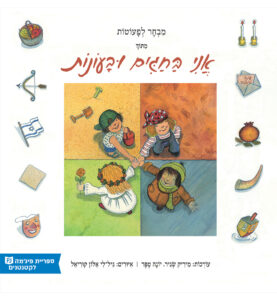 The holidays, seasons and me
The holidays, seasons and me 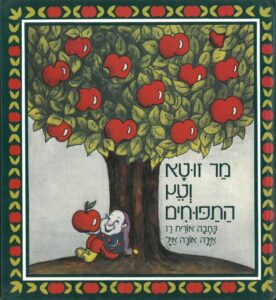 Mr. Zuta and the Apple Tree
Mr. Zuta and the Apple Tree 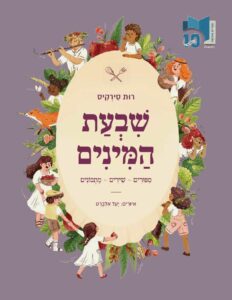 The seven species
The seven species 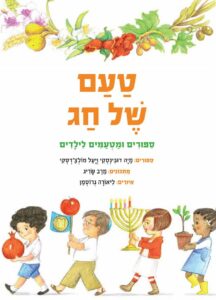 Festive Flavors
Festive Flavors 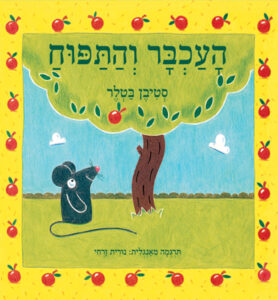 The Mouse and the Apple
The Mouse and the Apple 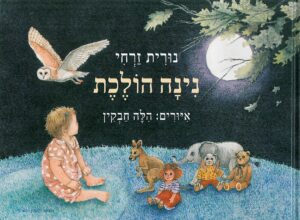 Nina Walks
Nina Walks 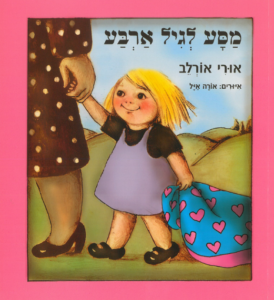 Journey to Age Four
Journey to Age Four 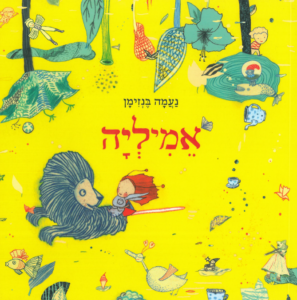 EMILIA
EMILIA 
